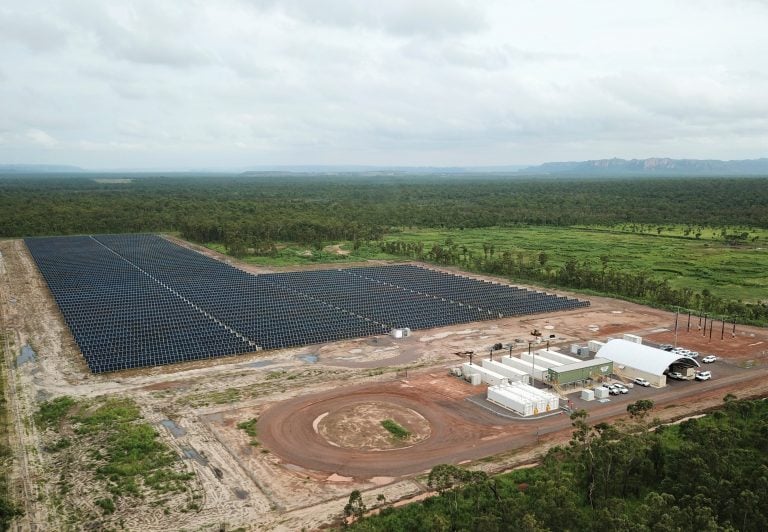
Two recently completed hybrid projects in Australia have enabled a gold mine and a remote township to run at 50% or more average penetration of renewable energy.
In both instances, the integration of battery energy storage systems (BESS) has been key to achieving the high threshold of solar and wind use and at times will enable the mine and township to run at 95% – 100% renewable energy.
Enjoy 12 months of exclusive analysis
- Regular insight and analysis of the industry’s biggest developments
- In-depth interviews with the industry’s leading figures
- Annual digital subscription to the PV Tech Power journal
- Discounts on Solar Media’s portfolio of events, in-person and virtual
The Australian Renewable Energy Agency (ARENA) said last week that the microgrid at Agnew Gold Mine in Western Australia, has been successfully operating since it went online in November last year.
The project received AU$13.5 million (US$9.87 million) funding support from ARENA, which has also supported similar projects elsewhere in the country — at Weipa, a bauxite mine owned by Rio Tinto and DeGrussa, a copper and gold mine owned by Sandfire Resources.
The first example of a remote microgrid at a mining site in the country to incorporate wind turbines as well as solar PV, 18MW of wind turbines are now paired with a 4MW solar PV plant at Agnew Gold Mine. Also on site is a 13MW/4MWh BESS, along with some gas and diesel generators (21MW) which remain in standby mode to provide backup.
As Energy-Storage.news reported when initial phases of the project went into operation in September 2020, the BESS was supplied by French battery manufacturer and system integrator Saft, a subsidiary of energy major TotalEnergies.
Saft’s Intensium Max 20-ft containerised BESS equipment was used, integrated with power conversion system (PCS), transformers and MV switchgear in separate containers. The batteries help maintain power quality to mining operations while also providing spinning reserve to maintain the microgrid’s stability, which further minimises the need for thermal generators to keep running.
Stuart Mathews, executive VP of Gold Fields, which owns the mine, described the project as a “testament to what can be achieved by taking courageous decisions and demonstrating true leadership in how we can sustainably energise our mines in remote environments,” and added that it could provide a framework for similar projects.
Sustainable energy project company EDL carried out the project. The company’s CEO James Harman said it had been brought online on time and on budget despited bushfires and pandemic-related issues.
EDL said the microgrid is achieving its required 99.9% reliability criteria, enables between 50% and 60% renewable energy penetration. At times that figure is as high as 95%.
Northern Territory township runs 100% on solar in daytime
EDL also announced in February the completion of a solar-battery-diesel power station project in the township of Jabiru, a remote area in Australia’s Northern Territory.
It has a 3MW/5MWh BESS and 3.9MW solar PV plant with 4.5MW diesel generators.
Jabiru is aiming to become a sustainable tourism and services hub for the region and the project will support those aims. During the daytime, the hybrid system draws 100% on renewable energy, with the battery kicking in from the evening, supported by diesel backup, Harman said.
This means that over the course of a year, Jabiru will run on 50% renewables — in line with the Northern Territory’s state government target to reach 50% renewable energy by 2030.
EDL said it has now done four hybrid renewable projects of this type and the Jabiru project in particular leaned on what the company had learned from its project for Coober Pedy, a town in remote South Australia which is off-grid.
Coober Pedy runs on an average of 75% renewable energy since completion of EDL’s project and has on one occasion since 2017 run on 100% renewable energy for four consecutive days.
The Jabiru project was supported with funding from the Northern Territory government.






